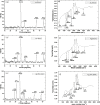Delpinium uncinatum mediated green synthesis of AgNPs and its antioxidant, enzyme inhibitory, cytotoxic and antimicrobial potentials
- PMID: 37014921
- PMCID: PMC10072477
- DOI: 10.1371/journal.pone.0280553
Delpinium uncinatum mediated green synthesis of AgNPs and its antioxidant, enzyme inhibitory, cytotoxic and antimicrobial potentials
Abstract
Green synthesis of nanoparticles is becoming a method of choice for biological research due to its environmentally benign outcomes, stability and ease of synthesis. In this study, silver nanoparticles (AgNPs) were synthesized using stem (S-AgNPs), root (R-AgNPs) and mixture of stem and root (RS-AgNPs) of Delphinium uncinatum. The synthesized nanoparticles were characterized by standardized techniques and evaluated for their antioxidant, enzyme inhibition, cytotoxic and antimicrobial potentials. The AgNPs exhibited efficient antioxidant activities and considerable enzyme inhibition potential against alpha amylase, acetylcholinesterase (AChE) and butyrylcholinesterase (BChE) enzymes. S-AgNPs showed strong cytotoxicity against human hepato-cellular carcinoma cells (HepG2) and high enzyme inhibitory effect (IC50 values 27.5μg/ml for AChE and 22.60 μg/ml for BChE) compared to R-AgNPs and RS-AgNPs. RS-AgNPs showed significant inhibition of Klebsiella pneumoniae and Aspergillus flavus and exhibited higher biocompatibility (<2% hemolysis) in human red blood cells hemolytic assays. The present study showed that biologically synthesized AgNPs using the extract of various parts of D. uncinatum have strong antioxidant and cytotoxic potentials.
Copyright: © 2023 Rehman et al. This is an open access article distributed under the terms of the Creative Commons Attribution License, which permits unrestricted use, distribution, and reproduction in any medium, provided the original author and source are credited.
Conflict of interest statement
The authors have declared that no competing interests exist.
Figures









References
-
- Colvin V.L., Schlamp M.C., and Alivisatos A.P. Light-emitting diodes made from cadmium selenide nanocrystals and a semiconducting polymer. Nature, 1994. 370(6488): p. 354–357.
-
- Khalil A.T., et al.., Microbes-mediated synthesis strategies of metal nanoparticles and their potential role in cancer therapeutics. in Seminars in Cancer Biology. 2021. Elsevier. - PubMed
MeSH terms
Substances
LinkOut - more resources
Full Text Sources
Molecular Biology Databases
Miscellaneous

